7 Secrets About Buying Cashmere, According to Stylists
Soft to the touch doesn't always mean a garment is high-quality.

For most of us, the word cashmere is synonymous with soft and cozy. By definition, it's the fine wool from the undercoat of Kashmir (or cashmere) goats. But why, then, are some cashmere sweater $50 and others $500? The answer is that all cashmere is not created equal, but the ways to spot the sub-mar material aren't so simple for average shoppers. That's why we turned to stylists to get their top secrets about buying cashmere. Read on to learn why a clothing label only goes so far and what is, surprisingly, not a dealbreaker.
READ THIS NEXT: 5 Tips for Wearing Jeans If You're Over 60, According to Style Experts.
1
A clothing label only tells you so much.
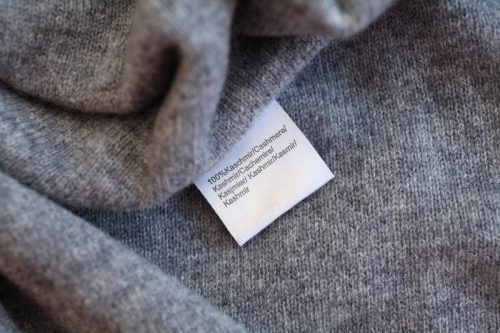
We've all been there. You walk into a store and see a table full of "cashmere" sweaters for a great price. But before you run to the register, take a close look at the tag.
"In clothing and accessories, cashmere is often mixed with other fibers," explains Holly Chayes, a personal style coach and consultant. "Look at the tag inside a piece of clothing or the materials section of an online listing—this should tell you what fibers are included and have percentages for each type of fiber." A 100-percent cashmere item will say just that and not include any other fiber percentages.
But even if something is fully cashmere, the material comes in three grades, a rating system that specifies softness. "Grade A is the highest quality and lightest weight, though still eight times warmer than wool. Grade B is thicker and less fine while Grade C is the thickest, coarsest and often not considered as pure," shares Elizabeth Kosich, personal stylist at Elizabeth Kosich Styling. The gradings are typically only used by the trade, but some brands will note it, usually if it's an A.
In addition, the location of the goats can make a difference in quality, too. According to Hao Rong, founder of clothing and accessories brand State Cashmere, "Inner Mongolia is one of the best origins."
2
But the label has a secret clue, too.
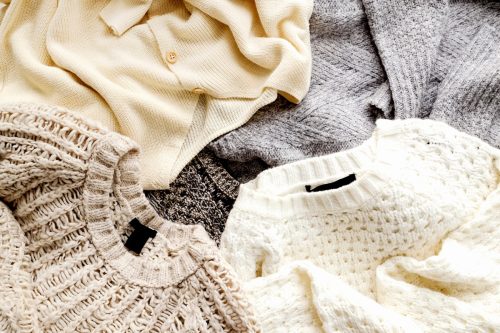
Trying to determine whether something is actually 100 percent cashmere? Don't just look at what the label says, but how it's affixed to the garment.
"If any tags and labels are glued onto the product, the cashmere is not real," explains Rong. "Genuine cashmere pieces will have tags sewn in because the glue cannot stay on real cashmere for long."
READ THIS NEXT: 7 Secrets You Need to Know Before Shopping at Outlet Stores, According to Experts.
3
There are a few simple "tests" to discern the quality of cashmere.
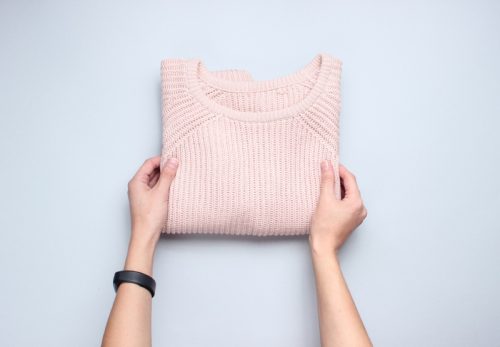
According to Mongolian cashmere brand Naadam, "cashmere fibers are six times finer than strands of human hair." They're also "some of the only fibers in the world that are hollow." So, not only is the material incredibly soft, it's ultra-lightweight, too.
However, their hollow nature makes them easy to blend with other fibers, many of which can feel just as soft as pure cashmere but won't hold up as well.
To determine whether what you're feeling is Grade A cashmere, Sissy Aerenson, owner of Delaware-based clothing store Peter Kate, recommends holding the garment up to the light "to see if the knitting is consistent rather than patchy."
And speaking of tight knitting, Rong points to the stretch test. "Gently stretch out the portion of the garment—see how long it takes for the cashmere to bounce back to its original shape. Low-grade cashmere will stay in its stretch form/become misshapen. Pure cashmere will bounce right back."
4
Looking at seams is a good way to find affordable high-end cashmere.
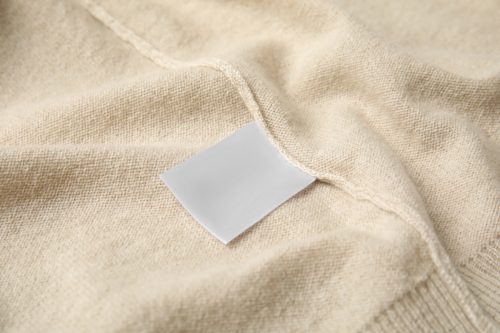
As Kosich notes, producing a seamless sweater is the most cost-intensive. "If you're budget-conscious but don't want to sacrifice quality, look for side seams." These won't be as noticeable and don't necessarily affect the overall quality.
But do be mindful of the gauge (how tightly something is stitched) of the seams. "The smaller the gauge, the finer quality and higher grade the cashmere. So, if stitch details are difficult to discern, that's a good thing," Kosich adds.
5
Pilling doesn't mean cashmere is bad.
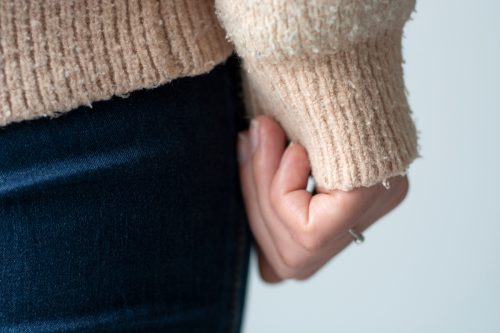
The lower the grade of the cashmere, the most prone it will be to pilling. "When shopping in-store, you can spot high-quality cashmere with its cozy, lightweight feel, and a minimal height of visible 'fluff' from the fibers due to the woven texture of longer hairs," explains Aerenson.
But even the best cashmere can be prone to pilling after lots of wear. In these cases, Kosich advises against ever using electric pill removers or razor blades. "Both can ruin sweaters in an instant." Instead, she recommends a handheld pill tool or a fine-tooth comb.
For more style advice delivered straight to your inbox, sign up for our daily newsletter.
6
This is why the best cashmere is so expensive.
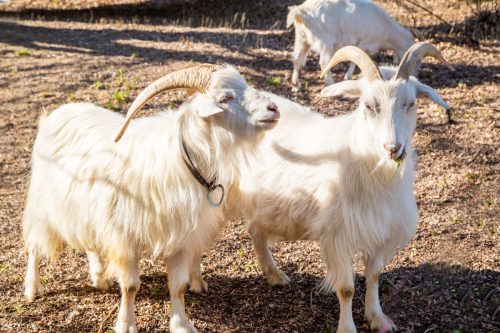
On their website, State Cashmere explains that it takes four to five cashmere goats to make one sweater. "The process of combing and collecting the under layer is pretty labor-intensive as the undercoat has to be separated from the outer layer by hand," they note, adding that cashmere is only collected once a year.
In addition, there are only so many cashmere-producing goats in the world. "Cashmere is scarce relative to wool; over two million tons of sheep wool is produced each year, while a little less than seven tons of cashmere is produced in the same period," shares clothing brand Lands End.
7
Use your freezer to keep cashmere fresh.

No matter how much you've spent on cashmere, you'll want it to last as long as possible, and for that to happen, the work doesn't stop in the store.
First, make sure you're storing it properly. Kosich recommends a place that is dry and has good airflow. "Avoid plastic bags as they can trap moisture. Also avoid cardboard boxes—they break down cashmere fibers over time and ultimately destroy them," she adds.
And, of course, only dry clean cashmere according to an item's specific care instructions. Generally speaking, Lands End advises dry cleaning twice a year—in the middle and at the end of the season.
After each individual wear, Lands End suggests placing your garment in a plastic bag and putting it in the freezer to kill odor and bacteria. "When you remove your clothing from the freezer, put it on a hanger, give it a spritz of cashmere spray—a clothing refresher that contains a little cedar oil—and hang it in the bathroom during your shower to steam out," they say.





















